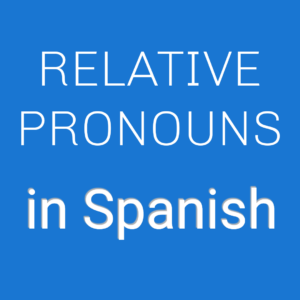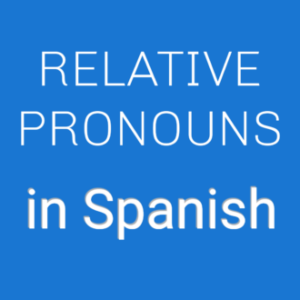Learn how and when to use the relative pronouns in
Spanish.
Qué, Quién: Relative Pronouns in Spanish
Que: relative pronouns
One way to view relative pronouns is to recognize that they combine two sentences that share a common noun.In the following examples, the common nouns are “butter” or “mantequilla”; “homework” or “tarea”e.g.¿Dónde está la mantequilla? – Where is the butter?Compraste mantequilla. – You bought butter.¿Dónde está la mantequilla que compraste? – Where is the butter that you bought? ¿Dónde está la tarea? – Where is the homework?Hiciste la tarea – You did the homework¿Dónde está la tarea que hiciste? – Where is the homework you did?
Note: Another way to view relative pronouns is to recognize that they are used to introduce a clause that modifies a noun.e.g.Terminé el trabajo anoche. – I finished the job last night.Era demasiado el trabajo. – It was to much work.El trabajo que terminé anoche era demasiado – The work I finished last night was too much The most common relative pronoun and the one used in the previous two examples is “que”. It can be used to refer to both persons and things, in either the subject or the object position. “Que” is the Spanish equivalent of the English words: “who, whom, which, and that”.e.g.El hombre que es pobre … (person, subject) – The man who is poor…
Los libros que son extensos … (thing, subject) – The books which are long …La señorita que conocí … (person, object) – The young lady whom I met …La carta que leíste … (thing, object) – The letter that you read …
Tip: The relative pronoun is often omitted in English, but it is never omitted in Spanish.e.g.La casa que compramos es nueva. – The house (that) we bought is new.El programa que miraba era cómico. – The show (that) I was watching was comical. Quien: relative pronouns
Note: The relative pronoun “quien” is used only to refer to people, and has a plural form “quienes” (There is no masculine/feminine distinction)e.g.Mi sobrina, quién es estudiante de la universidad, participará en el concurso. – My niece, who is a student at the university, will participate in the contest.El muchacho, con quien hablaste, es mi hermano – The boy, with whom you spoke, is my brotherQuien habla mucho, hace poco – Who talks a lot, do little Note: When the relative pronoun refers to a person and is in the direct object position, either “que” or “a quien” may be used. Notice that the personal “a” is used with “quien” but is not used with “que”.e.g.La chica que ayudé, era muy alta – The girl whom I helped was very tallLa chica a quién ayudé, era muy alta – The girl whom I helped was very tall Note: When the relative pronoun occurs after a preposition and refers to a person, “quien” must be used. After a preposition, “que” is only used to refer to things.e.g.Los estudiantes, con quienes competimos, eran más inteligentes – The students, with whom we compete, were smarterEl libro en que pienso es caro, no es barato – The book that I think about is expensive, it’s not cheapRead more about the Spanish grammarPopular Spanish categories to find more words and phrases:
A new category where you can find the top search words and phrases translated into English and Spanish. Be an expert in no time!
A new category where you can find the top search words and phrases translated into English and Spanish. Be an expert in no time!
This category has hundreds of words translated into Spanish and English. Just like a dictionary!
This category has hundreds of words translated into Spanish and English. Just like a dictionary!
In this Spanish category, you will find the translation of words and phrases in Spanish, with many sentences that will help you determine how each phrase or word is applied.
In this Spanish category, you will find the translation of words and phrases in Spanish, with many sentences that will help you determine how each phrase or word is applied.
Here are several infographics if you are looking to learn or teach the basic Spanish vocabulary for foreigners. Learn basic Spanish. Videos and resources to learn basic Spanish, Spanish for beginners.
Here are several infographics if you are looking to learn or teach the basic Spanish vocabulary for foreigners. Learn basic Spanish. Videos and resources to learn basic Spanish, Spanish for beginners.
The different verb tenses of Spanish are essential to understanding the language. Find out how to refer to the past, present, and future.
The different verb tenses of Spanish are essential to understanding the language. Find out how to refer to the past, present, and future.
Spanish to Go offers introductory courses you can take to learn Spanish online at your own pace. Whether you are learning Spanish to study or because you want to travel to a Spanish-speaking country. Find online courses to learn grammar, and basic Spanish.
Spanish to Go offers introductory courses you can take to learn Spanish online at your own pace. Whether you are learning Spanish to study or because you want to travel to a Spanish-speaking country. Find online courses to learn grammar, and basic Spanish.
Study Spanish grammar, learn the rules, and know-how and when to apply them.
Study Spanish grammar, learn the rules, and know-how and when to apply them.



Leave a Reply
You must be logged in to post a comment.